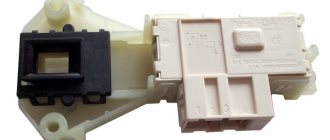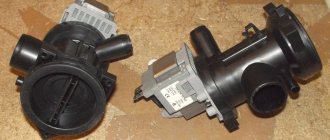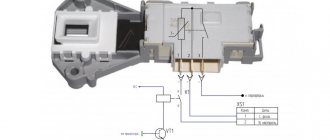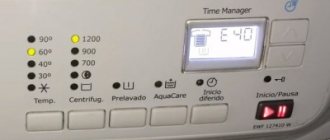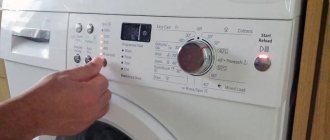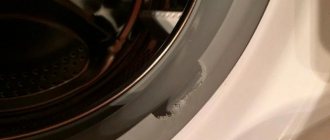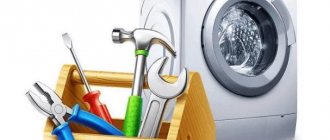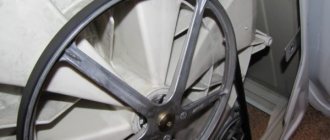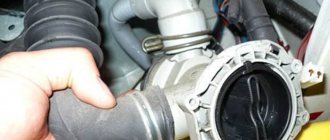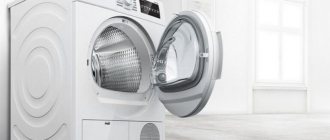External damage
The lock may not close due to normal wear and tear or rough handling. For example, sometimes wet things are hung on the door, which with their weight can damage the mechanism. Damage may also occur if the unit is closed with excessive force.
The device may not close for several reasons:
- As a result of prolonged use, the washing machine door was warped.
- The locking tab in the lock mechanism was misaligned.
- The plastic element or rubber gasket has worn out.
Identifying this type of fault is not difficult. To check, you can perform a test closure in normal mode, without loading laundry. If the door does not close under such conditions, it means that the lock has broken down or the fastening is skewed. Sometimes this may be due to improper installation, and then in an uneven position the hatch may warp under the influence of weight and vibrations. How to install a washing machine correctly - read here.
You can debug the operation of the machine yourself. Carefully inspect the device and locking mechanism. Check:
- Are there any objects preventing it from closing? Sometimes things can completely or partially fall under the hatch and jam the system.
- Condition of the locking hook: does it fit into the groove?
- Is the locking tab in place properly?
- Signs of peeling of plastic or rubber gasket.
Problems with the lock hook
The machine door is locked with a hook that ends the shutter rod. It is this hook that should fit into the socket and secure the structure. As a result of wear, vibration and other factors, the supporting rod may move out of its place and not fall into the socket at the moment of closing. The door may not close or may close without the door closing sensor operating.
The problem can be solved this way: dismantle the hatch door and unscrew it around the perimeter. Open the hatch parts, install the hook base in place and assemble everything in reverse order.
Hatch door sagging
The door frame is usually made of plastic. All fasteners (hinges) are made of metal. Plastic is softer than metal, and over time it wears out and deforms at the point of contact. As a result, the hatch door may sag, and as a result, the lock hook does not go where it is supposed to when closing. In such a situation, it is necessary to replace either the entire door or the fastening parts. This can be done using the following algorithm:
- remove the hatch door;
- disassemble it and replace damaged elements;
- put the door in place.
Over time, the hatch door may sag
Broken door handle
The assembled lock mechanism consists of the following elements: handle, lock hook, lock rod, spring. Breakage of any part results in the door not locking or closing/opening.
According to statistics, the door handle most often fails, since it is subject to the most active influence from the user. To replace any of the listed parts, you need to disassemble the entire door and replace the handle.
The most common thing to break is the hatch door handle.
To repair the handle:
- unscrew the door;
- disassemble it into components;
- remove the old handle;
- install a new part;
- assemble the door and install it in place.
Mechanical damage
Mechanical damage to the hatch door can be caused by careless handling or natural wear and tear. This happens when heavy wet things are hung on the hatch door, leaned on, or slammed hard.
— breakage of the hatch door handle
In some cases, the machine may not lock due to damage to the washing machine hatch door handle. This may occur due to improper use. To eliminate the problem, the handle must be replaced.
The hatch handle is replaced with the washing machine door removed.
To do this, dismantle the front clamp - a crimp ring that tightens the rubber cuff of the hatch. After this, the cuff must be bent and, using a wrench, the nuts securing the bolts intended for fixing the hinge must be secured. This will allow you to unscrew the bolts that connect the hinge to the body of the washing machine and remove the hatch along with the hinge. If necessary, at this stage you can completely replace the hatch door of the washing machine by repeating the above steps in reverse order, but using a new, working hatch.
The removed door should be installed with the glass facing up on a flat surface so that there is access to the fastening screws connecting the halves of the plastic case. All screws are unscrewed along the perimeter of the door and the halves are disconnected. Next, you need to remove the glass and lay the inner part of the rim on a flat surface - this way you can gain access to the fastening of the machine handle. The handle is connected to the body using a pin inserted into the holes in the handle and body of the washing machine.
To dismantle the handle, move the pin to the side and disconnect the handle, mounting spring and tongue in turn. The handle is usually supplied with consumable parts - a tongue, a pin and a spring. When installing a new handle, start with the spring, then install the tongue. When installing parts, care must be taken to ensure that the holes of the parts and the housing are aligned. After this, the pin is inserted and the handle is installed.
- skewed locking tongue or hinges on the door
If the door cannot be closed completely , and something prevents it from closing completely, most likely the main functional elements of the door - the hinges or the locking tab - have shifted or failed.
To eliminate the malfunction, check the level of the door and the tightness of the fixing elements of the hatch. If there is a visible distortion, the door must be adjusted or damaged hinges replaced.
Replacing the washing machine hatch door hinge is easy to do with your own hands. First of all, you should disconnect the door and hinge from the machine body.
To replace, the hinge must be separated from the door. Washing machines of different brands have different types of hinge fastenings. Some manufacturers (Ariston, Indesit) fix the hinges in such a way that they can be dismantled without removing the door. To do this, just unscrew 4 screws. In most washing machines, the doors are designed in such a way that to remove the hinge, you must disassemble the door.
To disassemble the door, unscrew the screws that connect the plastic halves with glass installed between them. With some effort, you should separate the halves from each other. You don’t need to press too hard - this could break the entire door; you need to press in different places in a circle. After the plastic halves of the doors are disconnected, you can replace the old hinge with a new one by installing it in the same location. After installing the hinge, the plastic halves of the door must be pressed firmly against each other until a click appears. To install the door, perform the above steps in reverse order.
If the door is locked correctly, then the fault lies in the locking tab . This happens if the tongue does not fit into the lock. The reason for this phenomenon may be the displacement of the metal rod designed to fix the tongue in a certain position.
To eliminate the malfunction, it is necessary to disassemble the hatch door and place the rod in its original place. If the rod is damaged, the rod must be replaced.
- deformation of the plastic guide
If the door closes normally, but without a click and the hatch cannot be locked in the closed position, it means that the plastic guide, which is used in some models of washing machines to lock the hatch door, has become deformed. It is made of a thin layer of plastic and can be erased as the washing machine is used. To eliminate the malfunction, it is necessary to replace the part by first disassembling the hatch door.
Failure of the hatch locking device (UBL)
On the machine side, the process involves a hatch locking device (UBL). Its purpose is to lock the lock and not open it until the washing cycle is completely finished (all this time voltage is supplied to the UBL), thereby preventing unauthorized opening of the door and water spillage. The UBL can fail for two reasons: there is a breakdown in itself, or there is no voltage going to it.
The body of this device is made of plastic. The lock is locked under the influence of current, which simultaneously heats the mechanism. This leads to damage to the plastic and its deformation. As a result, the entire node becomes inoperative.
The second option is mechanical failure as a result of the shock load to which the UBL is exposed during washing/spin due to vibration of the machine. In any case, there is only one solution to the problem - replacing the block. You can do this yourself:
- pull out the spring securing the hatch cuff;
- unscrew the UBL fasteners;
- remove the block by disconnecting the contacts (after writing down, or better yet photographing, which wire goes to which contact);
- Attach the contacts to the new part in the correct layout (based on the photo taken a step earlier), secure the UBL in its place.
Characteristic symptoms and causes of failure
After loading the laundry into the drum and closing the door, it is fixed by the UBL (hatch locking device) to prevent accidental opening and flooding of the room during the washing process. If the commit fails, the selected program does not run. The reasons why the hatch does not close are both mechanical damage and electronic malfunctions.
The mechanism defect is associated with a malfunction of the door lock, which does not provide locking. The electronic unit is responsible for fixing the locking mechanism after it is closed. If there is a loose fit, modern household appliances notify owners with light and sound indications.
The most typical reasons why doors do not lock are:
- Skewed or loose hinges. As a result, the latch tongue does not align with the groove. The hook does not fall into the well even if the rod falls out.
- Deformation of the plastic guide located in the lock. The part is quite thin and is erased during the process of opening and closing due to sagging of the hinges. If the guide is severely damaged, the hook will no longer fit into the lock groove.
- The locking device is faulty. The defect occurs due to wear of the bimetallic plates, which, deformed under the influence of current, close the contact of the electromagnet.
- The UBL hole is clogged with small debris that comes from clothing pockets and prevents the mechanism from operating.
- Malfunctions in the operation of the electronic board or wiring due to power surges, leading to software failure, peeling of tracks and burnout of microcircuits.
Electrical and electronic problems
The washing machine door may not lock if the contacts to the lock, UBL or sensors are broken. This often happens due to strong vibration of the machine. You can find a break by simple inspection. A soldering iron and electrical tape will help solve the problem.
Another situation: failure of the control unit. In this case, the processor simply does not issue commands to lock the lock, as a result - the door is not closed and the wash does not start. Visually, you can find melted or torn elements on the control unit board. In this case, the best thing you can do is call a service technician.
Mechanical problems
When looking for the reason why the door in the washing machine does not lock, you need to inspect the lock handle on the loading hatch. This is a frequent breakdown of older models of units that have been in operation for several years or even decades. Due to frequent use, the material becomes unusable and the locking mechanism breaks. In this case, the lock needs to be replaced.
Another common reason mentioned on forums is door misalignment. This can happen both with a new Veko, Ariston, Arcadia, Samsung washing machine and with an old one. In the first case, the quality of the components is likely low. In the second, something accidentally gets into the gap between the panel and the door. If the cause of the hatch misalignment is low-quality components, they need to be replaced.
Lock
If the door in the LG washing machine does not lock, the user may have applied pressure to the hatch. This could have happened accidentally or intentionally. Due to pressure, the locking rod moves, which must be in a certain position. Repairing the locking mechanism will help restore the door's functionality.
If the door of the LG, Indesit washing machine closes, but the characteristic locking click is not heard, the plastic guide has probably become unusable. This situation may arise due to intensive use of the unit or poor-quality parts installed on the device.
The lock is broken
